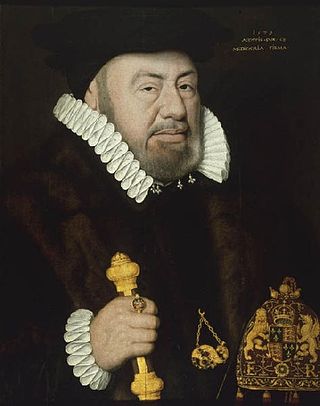Related Research Articles

Sir Nicholas Bacon was Lord Keeper of the Great Seal during the first half of the reign of Queen Elizabeth I of England. He was the father of the philosopher and statesman Sir Francis Bacon.

Charles Townshend, 3rd Viscount Townshend, known as The Lord Lynn from 1723 to 1738, was a British politician who sat in the House of Commons from 1722 to 1723 when he was elevated to the House of Lords by writ of acceleration.

Heraldic visitations were tours of inspection undertaken by Kings of Arms throughout England, Wales and Ireland. Their purpose was to register and regulate the coats of arms of nobility, gentry and boroughs, and to record pedigrees. They took place from 1530 to 1688, and their records provide important source material for historians and genealogists.
Sir Walter Acton, 2nd Baronet was an English landowner and politician who sat in the House of Commons in 1660.
Elizabeth Brooke, Lady Wyatt (1503–1560) was the wife of Sir Thomas Wyatt, the poet, and the mother of Thomas Wyatt the younger who led Wyatt's Rebellion against Mary I. Her parents were Thomas Brooke, 8th Baron Cobham and Dorothy Heydon, the daughter of Sir Henry Heydon. She was the sister of George Brooke, 9th Baron Cobham and was considered a possible candidate for the sixth wife of Henry VIII of England.
This is a list of sheriffs and since 1998 high sheriffs of Worcestershire.
This is a list of sheriffs and high sheriffs of Shropshire
Richard Pate was an English Roman Catholic bishop.
Sir John Hynde was an English judge, prominent in the reign of Henry VIII.

Sir Robert Crane, 1st Baronet of Chilton, Suffolk and of Buckenham Tofts, Norfolk, was an English politician who sat in the House of Commons variously between 1614 and 1643.
Sir John Pakington, was Chirographer of the Court of Common Pleas, a Member of Parliament for Gloucester, and Sheriff of Herefordshire and Worcestershire. In 1529 he received an extraordinary grant from Henry VIII permitting him to wear his hat in the King's presence.

Sir William Whitmore was an English landowner and politician who sat in the House of Commons at various times between 1621 and 1626.
Sir Robert Acton, of Elmley Lovett and Ribbesford, Worcestershire and Southwark, Surrey, was an English politician.
William Acton of Aldenham in Shropshire was an English politician who served in the parliament of Kingdom of England.
Lieutenant Admiral Sir William Woodhouse was an English naval commander and administrator who rose to the rank of Lieutenant of the Admiralty and was head of the Council of the Marine later called the Navy Board. He also served as a Member of Parliament of the Parliament of England from 1545 to 1564. He was prominent during an important time of the Navy Royal's development in the later half of the Tudor period.
Henry Woodhouse, of Hickling and Waxham, Norfolk, was an English politician.
SirBassingbourne Gawdy, of West Harling, Norfolk, was an English lawyer and judge, knight, and Member of Parliament.

Elmley Lovett in Worcestershire, England is a civil parish whose residents' homes are quite loosely clustered east of its Hartlebury Trading Estate, as well as in minor neighbourhood Cutnall Green to the near south-east. The latter is a loosely linear settlement that includes a pub-restaurant and farm shop on the Elmley Lovett side of the boundaries; it continues passing its near-square public green into the parish of Elmbridge, a similarly sized parish over to the east.
John Darras (c.1355–1408) was an English soldier, politician and landowner, who fought in the Hundred Years' War and against the Glyndŵr Rising. A client of the FitzAlan Earls of Arundel, he served them in war and peace, helping consolidate their domination of his native county of Shropshire. He represented Shropshire twice in the House of Commons of England. He died by his own hand.

Sir Clement Smith, son of Thomas Smith of Rivenhall, Essex, and Isabel, daughter of William Foster of Little Baddow, Essex, served as an administrator in the reign of Henry VIII and Edward VI. He was Lord Treasurer's Remembrancer in the Exchequer, and was twice MP for Maldon in Essex, in 1545 and 1547. He was knighted by Edward VI on 22 February 1547.
References
- 1 2 E. Brydges, Collins' Peerage of England, Genealogical, Biographical and Historical, greatly augmented (etc.), 9 Vols, II (London 1812), p. 457.
- ↑ G. Grazebrook and J.P. Rylands, 'Townshend of Ludlow', The Visitation of Shropshire taken in the year 1623, Part II, Harleian Society XXIX (London 1889), pp. 463–65; W. Rye (ed.), The Visitacion of Norffolk, etc Harleian Society Vol. XXXII (London 1891), pp. 290–92, from Harleian MS 1552.
- ↑ Lincoln's Inn Admission Register
- ↑ E. Foss, The Judges of England Vol. 5, (Longman, Brown, Green, Longmans and Roberts, London 1857), pp. 102–03.
- ↑ The children and their marriages are enumerated in M. Townsend, Townsend-Townshend 1066–1909. The History, Genealogy and Alliances of the English and American House of Townsend, Revised edition (New York 1909), p.24.
- ↑ The armorials are described in C.H. Townsend, 'The Townshend Family', in G. Boyd Roberts (ed.), Genealogies of Connecticut Families. From the New England Historical and Genealogical Register Vol. I, Adams-Gates (Clearfield/Genealogical Publishing Co. Ltd, 1983/2006), pp. 492ff., at pp. 494–95.
- ↑ A Description of the Town of Ludlow, with an Historical Account of the Castle (W. Felton, Ludlow 1812), pp. 8–9.
- ↑ N.M. Fuidge, 'Townshend, Henry (?1537–1621), of Cound and Ludlow, Salop.', in P.W. Hasler (ed.), The History of Parliament: the House of Commons 1558–1603 (Boydell & Brewer 1981), Read here; S. Healy, 'Townshend, Sir Henry (c.1537–1621), of Cound and Ludlow Castle, Salop and Lincoln's Inn, London', in A. Thrush and J.P. Ferris, The History of Parliament: the House of Commons 1604–1629 (Cambridge University Press, 2010), Read here (History of Parliament Online).
- ↑ Townshend', in Visitacyon of Norffolk, and 'Townshend of Ludlow' in Visitation of Shropshire, with additions as shown.
- ↑ M. Townsend, Townsend-Townshend, 1066–1909, p. 25.
- ↑ Will of Robert Townshend (P.C.C. 1615).
- ↑ Visitacion of Norffolk, p. 291; J.L. Chester, The Parish Registers of St Mary Aldermary, Harleian Society, Registers Vol. V (London 1880), p. 5.
- ↑ Will of Sir Henry Townesend (P.C.C. 1621)
- ↑ 'Burntwood: Manors, local government and public services', in M.W. Greenslade (ed.), A History of the County of Stafford: Volume 14, Lichfield (London, 1990), pp. 205–220. (British History Online. Retrieved 15 May 2016)
- ↑ M. Townsend, Townsend-Townshend, 1066–1909, pp. 24–25.
- ↑ M. Townsend, Townsend-Townshend, 1066–1909, p. 24.
- ↑ M. Townsend, Townsend-Townshend, 1066–1909, p. 25.
- ↑ Find A Grave
- ↑ History of Parliament , retrieved 23 November 2016
- ↑ Landed Families of Britain and Ireland, 166 Archer of Umberslade, 12 May 2015, retrieved 23 November 2016
- ↑ 'Cursonn', in Visitacion of Norffolk, pp.90–91, from Harleian MS 1552.
- ↑ M. Townsend, Townsend-Townshend, 1066–1909, p. 25.
- ↑ W.P.W. Phillimore (ed.), The Visitation of the County of Worcestershire made in the year 1569: with other pedigrees from Richard Mundy's collection, Harleian Society XXVII (1888) pp. 4–5.
- ↑ 'Parishes: Elmley Lovett', in A History of the County of Worcester: Volume 3 (London, 1913), pp. 106–10. (British History Online. Retrieved 17 May 2016)